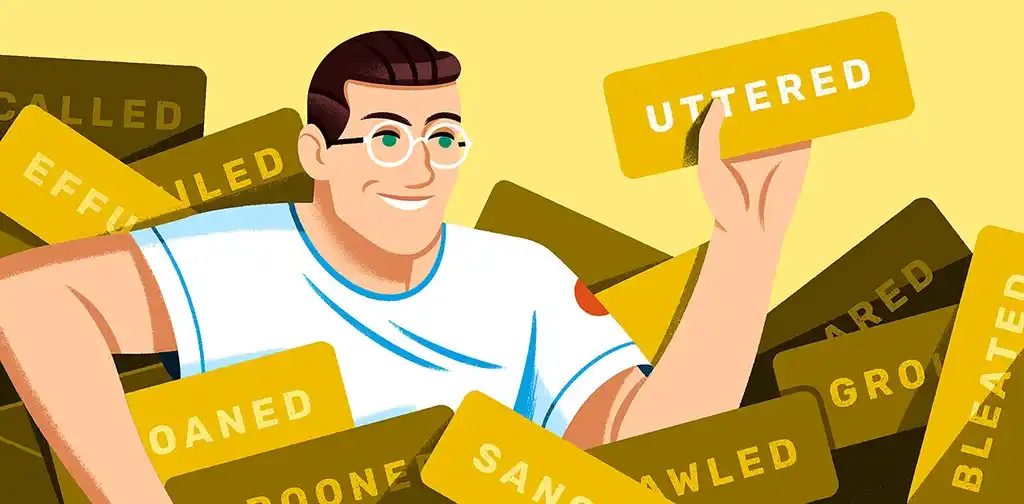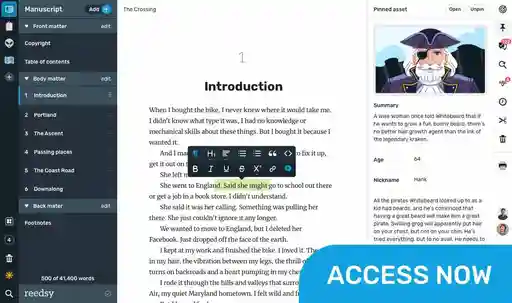Guides • Perfecting your Craft
Last updated on Oct 15, 2025
270+ Other Words For "Said" To Supercharge Your Writing
Martin Cavannagh
Head of Content at Reedsy, Martin has spent over eight years helping writers turn their ambitions into reality. As a voice in the indie publishing space, he has written for a number of outlets and spoken at conferences, including the 2024 Writers Summit at the London Book Fair.
View profile →If you've read our previous post on writing dialogue, you'll know that you shouldn't be afraid to default to he said, she said, or they said when you're tagging your dialogue. After all, it's probably the clearest, least distracting way to indicate who's saying what. That being said, it can be useful to deploy a specific and powerful dialogue tag every now and again.
👀
Which dialogue tag are YOU?
Find out in just a minute.
To help you find that perfect synonym to inject action and emotion into your dialogue, here are over 270 other words for said:
Q: What are some techniques authors can use to introduce characters naturally through dialogue?
Suggested answer
When you're going to create a character through dialogue, what you want to do is provide the reader with information about this individual without interrupting the action for exposition.
One good way to do that is to think about how actual people reveal themselves in conversation: through what they say, the cadence of their speech, and what they focus on. Instead of telling us about what a character is sure, nervous, or resentful of, you can make those qualities evident in what they say.
A certain sort of character might answer quickly or deflect, while an unsure one might lie or offer more questions than answers. You can also include context of hinting—perhaps another character does something in response to an unexpected comment, or someone uses a nickname that suggests history. This allows the dialogue not just to define who the character is, but also how they exist in relationships with the world around them. It's generally more engaging to give little hints than to tell everything.
By piling personality, background, and relationships onto conversations, you create a sense of authenticity so that readers feel they're reading about a real person rather than getting a synopsis.
John is available to hire on Reedsy ⏺
Dialogue is one of the most powerful ways to introduce your characters and bring them to life for readers. When done well, it reveals personality, relationships, and motivations—all in a way that feels natural and engaging. Here are a few techniques to make character introductions through dialogue memorable, with examples from authors I’ve worked with.
Show personality through speech patterns
The way a character speaks—their tone, choice of words, and rhythm—can reveal a lot about who they are. In Losing Juliet by June Taylor, the dialogue between two adult female characters is a perfect example. One character is guarded and precise, while the other’s tone is more casual and assertive. This contrast instantly tells us about their personalities and sets up their complex dynamic. When editing, I often help authors create unique speech patterns that make each character’s voice distinctive.
Reflect relationships through dialogue
How characters speak to each other reveals their relationship dynamics. In Losing Juliet, Taylor uses subtle hints in the dialogue to convey past secrets and tension without spelling it all out. Readers sense the history and conflict between the characters, making the dialogue feel rich and layered. When I work with authors, I encourage exploring these nuances in relationships, showing rather than telling.
Reveal motivation through subtext
Great dialogue often goes beyond what’s explicitly said. In The Hanged Man Rises by Sarah Naughton, the children’s dialogue is filled with innocence and curiosity, yet it often hints at deeper fears and uncertainties. This subtle layer adds intrigue without needing direct exposition. I frequently work with authors to find opportunities for subtext, letting readers read between the lines to discover characters’ hidden motivations.
Show conflict and tension
Conflict in dialogue can reveal a character’s core traits. In The Hanged Man Rises, Naughton’s children’s dialogue shows both their vulnerability and resilience, heightening the story’s suspense. In Losing Juliet, conversations between the protagonists highlight simmering anger and unresolved issues, offering readers a glimpse of what drives each character. When editing, I encourage authors to think about how characters might speak differently under pressure—revealing who they are when emotions run high.
Balance dialogue with actions and reactions
Dialogue is most impactful when paired with physical cues. In Losing Juliet, Taylor often uses gestures and subtle actions to deepen the impact of what’s said (or left unsaid). These small cues add depth, creating a more immersive experience. I often advise authors to integrate these details, as they can make dialogue feel more real and relatable.
Reflect character growth in speech
As characters evolve, so should their dialogue. In The Hanged Man Rises, Naughton’s young characters’ dialogue changes as they face challenges, reflecting their growth over the course of the story. This shift makes their journey feel authentic, and I often encourage authors to consider these changes as they develop characters’ arcs.
Shelley is available to hire on Reedsy ⏺
How much or how little a character "speaks" says a lot about them. A dialect can also reveal where they are from. Broken English or a stutter can also say a lot. Dialogue is a great way to "show" and not "tell."
Melody is available to hire on Reedsy ⏺
The main thing to get across when introducing characters through dialogue is to write it so it feels natural. Constantly ask yourself if the way you're making them speak is the way regular people in those circumstances would speak. If it sounds too stilted or infodump-y, that's going to distance your reader from the character because they'll feel unreal, manufactured—just there to move the plot along.
Brett is available to hire on Reedsy ⏺
Neutral/multi-purpose words
|
Acknowledged Added Agreed Announced Articulated Asserted Backtracked Began Blurted Called Commented Communicated Conferred Considered Contended Declared Denoted |
Drawled Elaborated Emitted Ended Enunciated Expounded Expressed Greeted Interjected Mentioned Noted Observed Orated Persisted Predicted Pronounced Quipped |
Recited Reckoned Related Remarked Repeated Replied Responded Shared Slurred Stated Suggested Told Urged Uttered Vocalized Voiced
|
Happy/excited words
|
Approved Babbled Beamed Bubbled Chattered Cheered Chimed in Chortled Chuckled Congratulated |
Complimented Crooned Effused Exclaimed Giggled Grinned Gushed Jabbered Joked
|
Laughed Praised Rejoiced Sang Smiled Thanked Tittered Trilled Yammered
|
Sad/upset words
|
Agonized Apologized Bawled Blubbered Cried Fretted |
Grieved Groaned Lamented Mewled Moaned Mumbled |
Sobbed Sighed Sniffled Sniveled Wailed Wept |
Angry words
|
Accused Choked Badgered Barked Bellowed Chastised Cursed Demanded Exploded Fumed |
Glowered Growled Hissed Insulted Raged Ranted Reprimanded Roared Scolded
|
Screamed Screeched Snarled Spat Shouted Swore Thundered Vociferated Yelled
|
Q: What are effective adjectives for describing characters, and when should each be used?
Suggested answer
My favourite from my writing has been "etiolated." It's a word that describes a seedling starved of sunlight - thin and pale and reaching up. It contains a lot of layers of imagery which were useful for describing a character at their lowest point.
Mairi is available to hire on Reedsy ⏺
Curious, rebellious. A character that doesn't quite "fit the mold" will usually be interesting to readers.
Melody is available to hire on Reedsy ⏺
Characters are best described through body language and dialogue. Avoid overusing adjectives and let your readers do some of the interpreting. There is no need to spell everything out for them. The best way to convey a character's personality is through action, dialogue and body language.
Eva maria is available to hire on Reedsy ⏺
Annoyed words
|
Bleated Complained Condemned Criticized Exhaled Groused |
Grumbled Grunted Heaved Insisted Mocked Rasped |
Rejoined Retorted Scoffed Smirked Snapped Whined |
Frightened/pained words
|
Coughed Cautioned Gulped Howled Keened Panted Prayed |
Quavered Screamed Shrieked Shuddered Squalled Squealed Trembled |
Wailed Warbled Whimpered Yelped Yowled Warned
|
Prideful words
|
Advertised Bloviated Boasted Boomed Bossed Bragged Broadcasted |
Crowed Exhorted Dictated Gloated Moralized Ordered
|
Prattled Preached Sermonized Snorted Swaggered Trumpeted
|

NEW REEDSY COURSE
How to Write a Novel
Enroll in our course and become an author in three months.
Words to express uncertainty
|
Breathed Doubted Faltered Hesitated Lilted Mumbled |
Murmured Muttered Shrugged Squeaked Stammered
|
Stuttered Swallowed Trailed off Vacillated Whispered
|
Q: What essential physical tools or items should writers always have on hand to help with the writing process?
Suggested answer
As an editor and a writer, the physical items I’ve carried with me have changed over the years. Back when I was a 90s teen, I always had a small notebook and pen in my car, purse, or backpack to jot down lines. I also almost always carried a physical book with me—what I was reading in school or for fun at home. Whether it was Great Expectations or The Mirror of Her Dreams, a book on the go filled the void and loneliness of the pauses in my teen life. The book I carried with me also gave me joy and energized me to do my own writing later when I was at home alone, listening to Spin Doctors or Jewel on my clunky CD-tape player.
Nowadays, a smartphone can do a lot for you and me if we let it. The Notes app on iPhones or other writing apps on Androids are great for taking down any poetic lines or other plot aha moments you might have while out with friends or coworkers or running around town getting errands done. As a mom, I often have to wait for my kids to get out of school or classes, so I read a book I’ve downloaded or an article on Substack on my phone to pass the time. (I also just scroll endlessly sometimes. Both things are totally fine!) The same can be done if you’re working nine-to-five and biding your time for a meeting to start.
If inspiration strikes, jot down what you’re thinking to get it out of your head before the bell rings or the meeting starts and life revs up again, the precious idea lost to cleaning out lunchboxes or putting out fires at your job.
If you’re having trouble using your phone as a writer’s tool, delete all your social media apps for a week, and see if it goes better. Do you find yourself writing more and scrolling less? Did you already try that and it not work? Then try to follow more writers on social media for inspiration. Even seeing writers’ day-to-day lives can be inspiring. What did they do yesterday? What shoes did they just buy? Sometimes even little things can motivate you to be in writer-mode.
Also, snacks. Never forget the snacks.
Sandra is available to hire on Reedsy ⏺
I'm a huge proponent of staying hydrated, so I will always recommend water. It's a great tool to give your brain space to think, too. Stuck? Take a sip of water. Finished a difficult line? Take a sip of water. Feeling achy after sitting too long? Take a sip of water.
Samantha is available to hire on Reedsy ⏺
A pocket notebook and pen or pencil. You never know when an idea will come around, or you suddenly figure out a solution to a writing problem. I keep one on me all the time, even if I'm sitting at my computer, because sometimes in the time it takes to decide what app/document to open, the thought will just vanish. It also gives me a chance to think visually, which is how I often work through things: mind-maps, doodles, sketches, and other ways of expressing myself that are not always easy to pull off with a keyboard.
And they're handy for impromptu to-do or shopping lists to boot!
Marisa is available to hire on Reedsy ⏺
Your smartphone! The quickest way to make sure you don't forget an idea is to record a voice note – save yourself the scramble for a pen and paper. Snapshots of places, scenes, details, and skies that inspire you are great for reference too.
Mairi is available to hire on Reedsy ⏺
A notepad or a phone as a way of taking verbal or written notes for ideas as they arise.
Melody is available to hire on Reedsy ⏺
I'm a sucker for a good pocket notebook. You never know when inspiration will strike, and while phone are great (and another note-taking device that works wonders) I've always found that physically writing something down helps the ideas flow more.
Sean is available to hire on Reedsy ⏺
Pen and paper if you're old-school.
Laptop (or in a pinch, smartphone) if you're new-school.
Coffee if you drink coffee; tea if you drink tea.
And when the words just aren't coming, access to whiskey and rum. 😉
Brett is available to hire on Reedsy ⏺
Words that make fun
|
Derided Jeered Heckled Lampooned Mocked |
Mimicked Parodied Ridiculed Satirized Scorned |
Spoofed Sneered Snickered Taunted Teased |
Words that ask a question
|
Asked Begged Challenged Contemplated Guessed Hinted Hypothesized Implied Inquired |
Interrogated Invited Mouthed Mused Pleaded Pondered Probed Proposed Puzzled |
Repeated Requested Requisitioned Queried Questioned Quizzed Solicited Speculated Wondered |
Q: What should I do if someone has already written a book with my idea?
Suggested answer
Write it anyway!
The market for books is huge and each writer's voice is unique. You will have a different way of presenting the informaiton or telling the story, even if it's similar to someone else's.
Alice is available to hire on Reedsy ⏺
Write a better book. There are many books written about the same topic, same ideas, same plots. You can't protect an idea, only the written expression of that idea. Go write your own book that is thoughtful, well-written, and thorough. A good book will find an audience.
Maria is available to hire on Reedsy ⏺
Words that give an answer
|
Accepted Advised Affirmed Alleged Answered Assured Avowed Claimed Conceded Concluded Confided Confirmed |
Explained Disclosed Disseminated Divulged Imparted Informed Indicated Maintained Notified Offered Passed on Proffered |
Promised Promulgated Released Reported Revealed Shared Specified Speculated Supposed Testified Transmitted Verified |
Download this 'greatest hits' list
For this infographic, we've narrowed down the 270 most essential dialogue words for you to know! Simply enter your email below to get it in your inbox within minutes.

FREE RESOURCE
Get our Dialogue Tag Cheatsheet
Upgrade your dialogue with our list of 270 alternatives to “said.”
To see how master writers assemble their dialogue, head over to our final post in this series for some choice examples of dialogue.

